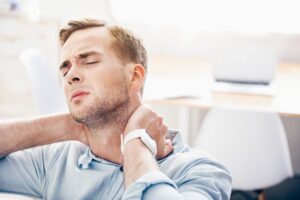Degenerative disc disease is an all too common spinal condition that affects millions of Americans each year. Due to osteoarthritis, trauma, repetitive strain and natural aging, the discs in our spine can start to thin out. When this happens, your body tries to address the issue by producing extra bone to help reinforce the structural integrity of the spinal column. This extra bone doesn’t always form perfectly, leading to the onset of bony nodules known as a bone spur or an osteophyte.
This extra bone can lead to a number of different symptoms if it ends up irritating soft tissues that lie in close proximity to the spinal column. Symptoms can vary significantly based on the location of these spurs, and in today’s blog, we take a closer look at what symptoms can present based on where these osteophytes develop.
Bone Spur Symptoms In The Spine
If you’re dealing with any of the following symptoms, it’s possible that your discomfort is being caused by bone spurs along the spine. Here’s what to look for based on the location of your bone spurs:
- Cervical Bone Spurs – If disc degeneration has developed in the uppermost portion of your spine, you may be dealing with cervical osteophytes. The most common symptoms associated with cervical bone spurs include dull neck pain, stiffness, pain that radiates to the shoulders, arms or hands, numbness or weakness in your upper extremities and headaches.
- Thoracic Bone Spurs – The rarest of the three types of bone spurs we’ll spotlight are thoracic bone spurs, which develop in the mid-back. The reason bone spurs rarely develop in this location is because it is rather stable and doesn’t typically handle significant stress when out of natural alignment, like the top or bottom of our spine does. Nevertheless, many people end up developing thoracic bone spurs, which tend to present with the following symptoms: Mid-back pain, limited mobility in the area, pain that travels to nearby areas like the arms, hips or buttocks and general weakness in the mid-back.
- Lumbar Bone Spurs – Your lower back can also develop bone spurs, especially if you sit for long periods with poor posture. This area of your spine handles the most stress when seated, so it is a common location for osteophyte development. Common symptoms associated with lumbar bone spur development include lower back pain, limited mobility, stiffness, weakness, a tingling sensation in your lower back, hips or buttocks or pain that radiates down one or both legs.
If you are dealing with any of these symptoms, consider reaching out to your primary care physician or a specialist in your area. There are a number of conservative treatment plans that can help alleviate symptoms caused by bone spurs, and the condition only tends to intensify if you ignore it, so don’t put off treatment any longer. Connect with Dr. Jackman and let him help put an end to your uncomfortable spinal bone spurs.
For more information, or to set up an appointment with Dr. Jackman, give the team at The Midwest Spine & Brain Institute a call today at (651) 430-3800.


 Why Chronic Back Pain Can Leave You Feeling Tired
Why Chronic Back Pain Can Leave You Feeling Tired